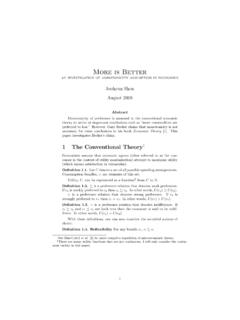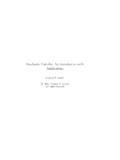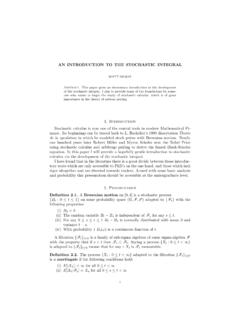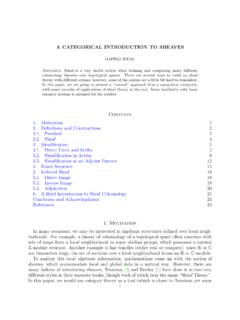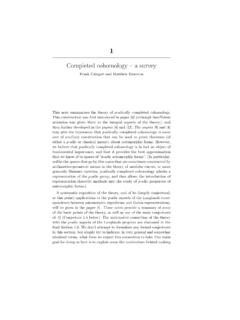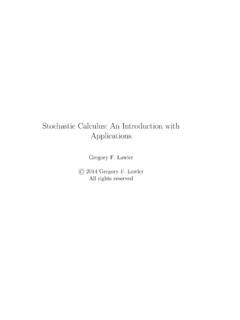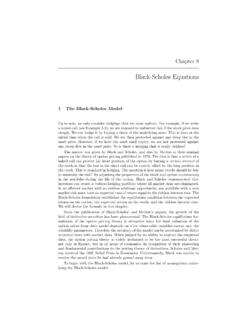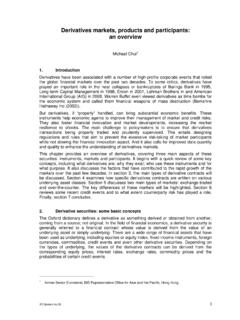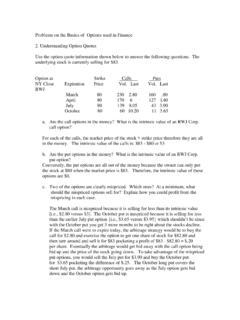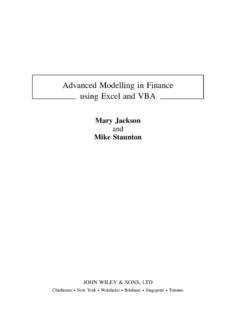Transcription of Stochastic Calculus: An Introduction with Applications
1 Stochastic Calculus: An Introduction withApplicationsGregory F. Lawler 2014 Gregory F. LawlerAll rights reservediiContents1 Martingales in discrete Conditional expectation .. Martingales .. Optional sampling theorem .. Martingale convergence theorem .. Square integrable martingales .. Integrals with respect to random walk .. A maximal inequality .. Exercises .. 282 Brownian Limits of sums of independent variables .. Multivariate normal distribution .. Limits of random walks .. Brownian motion .. Construction of Brownian motion .. Understanding Brownian motion .. motion as a continuous martingale.
2 Motion as a Markov process .. motion as a Gaussian process .. motion as a self-similar process .. Computations for Brownian motion .. Quadratic variation .. Multidimensional Brownian motion .. Heat equation and generator .. One dimension .. Expected value at a future time .. Exercises .. 78iiiivCONTENTS3 Stochastic What is Stochastic calculus? .. Stochastic integral .. of Riemann integration .. of simple processes .. of continuous processes .. It o s formula .. More versions of It o s formula .. Diffusions .. Covariation and the product rule .. Several Brownian motions.
3 Exercises .. 1204 More Stochastic Martingales and local martingales .. An example: the Bessel process .. Feynman-Kac formula .. Binomial approximations .. Continuous martingales .. Exercises .. 1435 Change of measure and Girsanov Absolutely continuous measures .. Giving drift to a Brownian motion .. Girsanov theorem .. Black-Scholes formula .. Martingale approach to Black-Scholes equation .. Martingale approach to pricing .. Martingale representation theorem .. Exercises .. 1806 Jump L evy processes .. Poisson process .. Compound Poisson process .. Integration with respect to compound Poisson processes.
4 Change of measure .. Generalized Poisson processes I .. Generalized Poisson processes II .. The L evy-Khinchin characterization .. Integration with respect to L evy processes .. Symmetric stable process .. Exercises .. 2327 Fractional Brownian Definition .. Stochastic integral representation .. Simulation .. 2418 Harmonic Dirichlet problem .. Time changes .. Complex Brownian motion .. Exercises .. 254viCONTENTSI ntroductory commentsThis is an Introduction to Stochastic calculus. I will assume that the readerhas had a post-calculus course in probability or statistics. For much of thesenotes this is all that is needed, but to have a deep understanding of thesubject, one needs to know measure theory and probability from that per-spective.
5 My goal is to include discussion for readers with that backgroundas well. I also assume that the reader can write simple computer programseither using a language like C++ or by using software such as Matlab advanced mathematical comments that can be skipped by thereader will be indented with a different font. Comments here will as-sume that the reader knows that language of measure-theoretic prob-ability will discuss some of the Applications to finance but our main fo-cus will be on the mathematics. Financial mathematics is a kind of appliedmathematics, and I will start by making some comments about the use ofmathematics in the real world . The general paradigm is as follows.
6 A mathematical model is made of some real world phenomenon. Usuallythis model requires simplification and does not precisely describe thereal situation. One hopes that models arerobustin the sense that if themodel is not very far from reality then its predictions will also be closeto accurate. The model consists of mathematicalassumptionsabout the real world. Given these assumptions, one does mathematical analysis to see whatthey imply. The analysis can be of various types:12 CONTENTS Rigorous derivations of consequences. Derivations that are plausible but are not mathematically rigor-ous. Approximations of the mathematical model which lead totractable calculations. Numerical calculations on a computer.
7 For models that include randomness,Monte Carlo simulationsus-ing a (pseudo) random number generator. If the mathematical analysis is successful it will make predictions aboutthe real world. These are then checked. If the predictions are bad, there are two possible reasons: The mathematical analysis was faulty. The model does not sufficiently reflect user of mathematics does not always need to know the details ofthe mathematical analysis, but it is critical to understand theassumptionsin the model. No matter how precise or sophisticated the analysis is, if theassumptions are bad, one cannot expect a good 1 Martingales in discrete timeA martingale is a mathematical model of a fair game. To understand the def-inition, we need to defineconditional expectation.
8 The concept of conditionalexpectation will permeate this Conditional expectationIfXis a random variable, then its expectation,E[X] can be thought of asthe best guess forXgiven no information about the result of the trial. Aconditional expectation can be considered as the best guess given some butnot total ,X2,..be random variables which we think of as a time serieswith the data arriving one at a time. At timenwe have viewed the valuesX1,..,Xn. IfYis another random variable, thenE(Y|X1,..,Xn) is thebest guess forYgivenX1,..,Xn. We will assume thatYis anintegrablerandom variable which meansE[|Y|]< . To save some space we will writeFnfor the information contained inX1,..,Xn andE[Y| Fn] forE[Y|X1.]
9 ,Xn]. We viewF0as no information. The best guess should satisfythe following properties. If we have no information, then the best guess is the expected other words,E[Y|F0] =E[Y]. The conditional expectationE[Y| Fn] should only use the informa-tion available at timen. In other words, it should be a function of34 CHAPTER 1. MARTINGALES IN DISCRETE TIMEX1,..,Xn,E[Y|Fn] = (X1,..,Xn).We say thatE[Y|Fn] definitions in the last paragraph are certainly vague. We can usemeasure theory to be precise. We assume that the random variablesY,X1,X2,..are defined on a probability space ( ,F,P). HereFisa -algebraor -fieldof subsets of , that is, a collection of subsetssatisfying F; A Fimplies that \A F; A1,A2.
10 Fimplies that n=1An informationFnis the smallest sub -algebraGofFsuch thatX1,..,XnareG-measurable. The latter statement means that for allt R, the event{Xj t} Fn. The no information -algebraF0is the trivial -algebra containing only and .The definition of conditional expectation is a little tricky, so let us tryto motivate it by considering an example from undergraduate probabilitycourses. Suppose that (X,Y) have a joint densityf(x,y),0< x,y < ,with marginal densitiesf(x) = f(x,y)dy, g(y) = f(x,y) conditional densityf(y|x) is defined byf(y|x) =f(x,y)f(x).This is well defined provided thatf(x)>0, and iff(x) = 0, thenxis an impossible value forXto take. We can writeE[Y|X=x] = y f(y|x) CONDITIONAL EXPECTATION5We can use this as the definition of conditional expectation in this case,E[Y|X] = y f(y|X)dy= y f(X,y)dyf(X).
